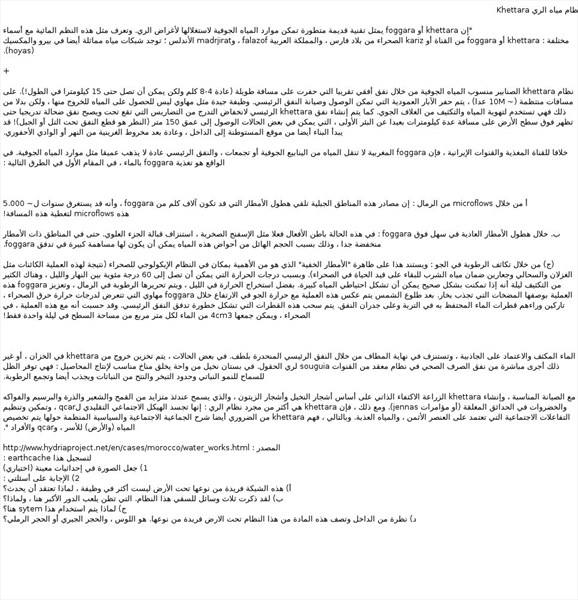Khettara water irrigation
system
„The khettara or
foggara represents an ancient sophisticated technique
which enables underground water resources to be tapped for
irrigation. Water systems like these are known with different
names: khettara or
foggara of the Sahara
desert qanat or kariz of
Persia, falazof Arabia, and
the madrjirat of Andalusia; similar water systems
are found also in Peru and Mexico (hoyas) .
 +
+
The khettara system taps the groundwater
table by means of a nearly horizontal tunnel which is dug over a
long distance (normally 4-8 km but can reach even 15 km in
length!). At regular distances (~10m apart), vertical shafts are
dug which enable access and maintenance of the main tunnel. The
function of the well-like shafts is not to
get water out of them, but instead they are used for aeration and
condensation of atmospheric water. As the khettara´s main tunnel is
constructed to have a lower gradient than the terrain under which it lies, the tunnel becomes
gradually shallower until it emerges above the ground at a distance
of several km far from the first well, which in certain cases can
reach a depth of 150 metres (considering the tunnel is cut under a
hill or mountain)! The construction may start also from the
settlement site inward, usually following an alluvial cone of a
river or fossil wadi.
Unlike a feeder canal and
the Iranian qanats, the
Moroccan foggara do not convey water from springs or underground pools, as
their main tunnel does not usually go as deep as groundwater
resources . Actually
the foggara is fed with water, primarily in the following
ways:
a. Through
microflows of the sands: The sources of these are
mountainous areas receiving rainfall that may be thousands of km
away from the foggara, and it may take ~ 5.000 years for these microflows to cover
this distance!
b. Through regular
rainfall in the plain above the foggara: In this case the subsoil actually
acts like a rocky sponge, draining off the upper part. Even in
areas with very low precipitation, because of the enormous size of
the basins this water can have a significant contribution to
the foggara outflow.
c. Through
condensation of atmospheric humidity: This is based on the
phenomenon of “hidden precipitation” that is of primary
importance in the desert ecosystem (due to this process organisms
like gazelles, lizards and scarabs ensure drinking water for their
survival in the desert). Because of a temperature range that can be
up to 60°C between day and night, there is a lot of night
condensation that if managed properly can form sizable water
reserves. Thanks to heat extraction at night, humidity is released
into the sand, and the foggara foster this process acting as
pumps that attract vapour. After sunrise the process is reversed
with heat the air in the foggara rises through the shafts
which are exposed to the burning temperatures of the desert,
leaving behind water droplets retained in the soil and in the walls
of the tunnel. These droplets are pulled by gravity form the
outflow of the main tunnel. It has been calculated that with this
process, in the desert, 4cm3 of water can be collected per square
meter of surface area in only one night!
The condensed water, relying
on gravity, eventually drains through the gently sloping main
tunnel. In some cases, the outflow of a khettara is stored in a reservoir, or
otherwise directly conducted from the drainage tunnel into a
complex system of souguia channels to irrigate the fields. The
palm grove of the oasis creates a microclimate suitable for crop
production: it provides shade to allow vegetable growth and limits
evaporation and transpiration from plants and also attracts and
collects moisture.
With proper maintenance,
the khettara create a self-sufficient agriculture based on palm trees
and olive trees, which then allows the growing of wheat, barley,
maize, alfalfa, fruits and vegetables in enclosed gardens (plots or
jennas). However, the khettara is more than an irrigation
system: It embodies the traditional social structure of a qcar,
enabling and regulating the social interactions that are based on
the most precious element, freshwater. Thus, to understand
the khettara it is necessary to explain also the
collective socio-political organization around which the water (and
land) is allocated to qcar, families and
individuals.“
Source:
http://www.hydriaproject.net/en/cases/morocco/water_works.html
To log this earthcache:
1) make photo at given coordinates (optional)
2) answer my questions:
a) This unique underground network is no more in function, why do
you think that happened?
b) I have mentioned three methods of watering this system. Which do
you think plays the biggest role here and why ?
c) Why is this sytem being used here?
d) Look inside and describe the material of this unique
underground system. Is it loess, limestone or
sandstone?
I dont speak arabic, I did my best ....so
sorry for translation mistakes
